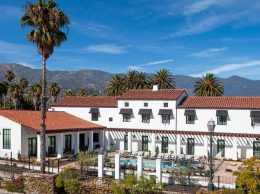Commission recommendation would benefit small wineries in Santa Barbara County
IN THIS ARTICLE
- Agribusiness Topic
- pacbiztimes Author
By pacbiztimes Monday, September 19th, 2016
Small wineries throughout Santa Barbara County cleared a major hurdle that could boost the region’s burgeoning wine industry.
After more than four years of workshops and public hearings, the Santa Barbara County Planning Commission recommended to allow tasting by appointment only at wineries in some of the fastest-growing wine regions in the county.
Much of the discussion focused on Tier A wineries, or those between 10 and 20 acres in size on unincorporated, agriculturally zoned land. The commission voted 4-1 at the Sept. 19 meeting to recommend an ordinance that would allow tasting rooms in Tier A wineries via a conditional use permit that would allow up to 20 people to sample wines in up to 300-square-foot rooms. The ordinance would not allow tasting in wineries smaller than 10 acres, or in “inner rural” areas.
The lasting debate has illustrated the inherent struggle to facilitate the growth of the flourishing wine industry and the economic fruit it bears while managing environmental impacts and neighbors’ quality of life.
Small wineries need direct-to-consumer sales to survive, operators argue, while critics contend that the region’s ill-equipped roads and dwindling water supply cannot accommodate more use.
The county does not currently have regulations that enable tasting at small wineries on ag land. Yet, getting the conditional use permit is no small endeavor, said Planning Commission Vice Chairman Michael Cooney, who doesn’t expect a flood of applications.
“I support a very limited intrusion on neighbors’ peace and quiet that would help some of these wineries and small businesses succeed,” Cooney said at the meeting.
The Environmental Impact Report listed a significant traffic quality of life impact that would be mitigated by limiting tasting by appointment, capping the total number of people and only allowing tasting at appropriately sized operations.
Winery owners like John Hilliard of Hilliard Bruce Vineyards in the Santa Rita Hills joined several wine operators at the meeting to support the ordinance. The company predominantly grows pinot noir and chardonnay on a 101-acre property between Buellton and Lompoc.
“Having scheduled tastings are essential for us to survive,” Hilliard said at the meeting. “If we can’t tell you who we are, how we grow our wine and why you should buy our wine, there is no other venue for us. Our alternative is to sell the grapes to Napa, Sonoma or Lodi and they sell our grapes for $60 a bottle.”
For smaller growers, dealing with distributors squeezes profit margins. Selling direct to consumers is likely the only way to remain sustainable, they said.
Grassini Family Vineyards in Happy Canyon in Santa Ynez Valley was awarded the Small Business of the Year from the Santa Barbara Region Chamber of Commerce, largely for its charitable giving, Katie Grassini said at the meeting. It loses 50 percent of the revenue when it works with a distributor, she said.
“That’s a tough margin,” Grassini said. “We want to be able to leave this for our kids and grandkids. Tasting by appointment is perfect. We don’t want bachelorette parties. We want people who are staying at the Bacara (Resort & Spa) and want to meet me and the winemaker. That’s how we get a customer for life.”
Since 1989, the Santa Barbara County Vintners Association has raised about $4 million for Direct Relief, more than $110,000 in scholarships, more than $105,000 for the Food Bank of Santa Barbara County and more than $65,000 for Santa Ynez Valley People Helping People, said Steve Fennell of the association and Sanford Winery and Vineyards.
“We do not want to arbitrarily restrict the efforts of wineries to help raise money for charities on their property,” he said.
The ordinance would allow Tier C wineries, which are more than 40 acres, to hold winery special events in excess of 12 per calendar year and more than 200 people at one time with a conditional use permit. The ordinance is now headed to the Santa Barbara County Board of Supervisors.
Those who opposed the ordinance were predominantly Ballard and Happy canyons residents who argued that the roads are too dangerous to handle more drivers, some of the events are too noisy and water resources are limited.
The tourism sector has been fueled by the wine industry, which had a $1.7 billion economic impact in the county in 2013, according to a 2015 study from the Stonebridge Research Group.
Wine grapes are the second highest crop value in the county at $155 million in 2014, according to the Santa Barbara County Ag Commissioner. Strawberries are the top crop at $465 million and broccoli comes in third at $137 million.
Wine grape crop value has been fluctuating between $80 million and $160 million over the past 10 years given drought and other cost-related impacts, according to UC Santa Barbara Economic Forecast Project data. The agricultural sector as a whole provides more than 20,000 jobs, which accounts for 10.5 percent of the total county workforce, and 3.8 percent of the county’s GDP with more than $1 billion in output.
• Contact Alex Kacik at [email protected].












